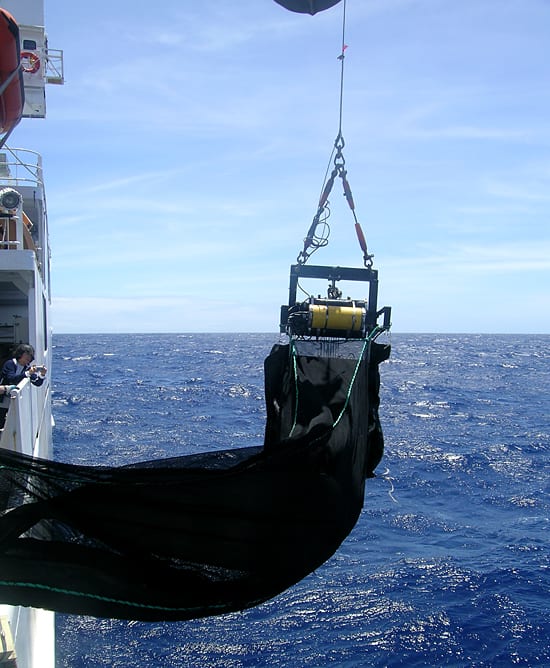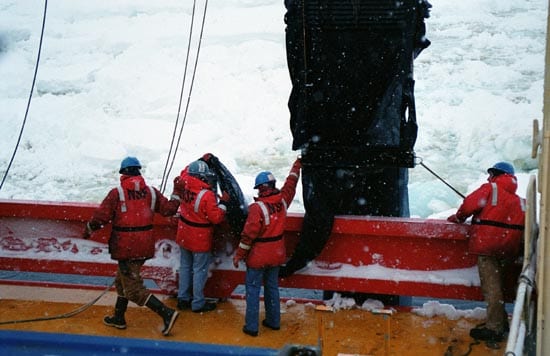MOCNESS
Multiple Opening/Closing Net and Environmental Sensing System
What is MOCNESS and why do we use it?
MOCNESS is a much-improved, high-tech version of the humble sampling net. The letters in MOCNESS refer to the specific improvements: it's a Multiple Opening and Closing Net, with an Environmental Sensing System.
As MOCNESS tows behind a research ship, each net can be opened and shut independently so that it samples a discrete patch of water. The researcher chooses exactly when by using the environmental sensing system. This is an array of sensors mounted on the instrument frame that relays water conditions up to the ship in real time. The data also help researchers match what they find in their sample to the physical properties of the seawater.
How does it work?
MOCNESS consists of a sturdy rectangular frame that carries sensors and controls anywhere from 6 to 20 nets. A research vessel tows MOCNESS at a crawl - 2 to 3 knots. The cable connecting ship and instrument also carries the data and allows scientists to control the instrument’s depth. MOCNESS can sample as deep as 6,000 meters (3.7 miles). Sensors report conductivity (salinity), temperature, depth, and chlorophyll, oxygen and light levels.
MOCNESS nets are long and tapered, like butterfly nets except much larger. They are up to 18 meters (60 feet) long and dyed black or dark blue to blend in with the surrounding waters. The rectangular opening cuts through a precise area of water during a tow and comes in six sizes: 0.25, 1, 2, 4, 10, and 20 square meters (2.7, 11, 22, 43, 108, and 216 square feet; sizes take into consideration that the frame leans at a 45 degree angle when underway).
The nets are made of fine mesh sized to catch specific kinds of plankton. Holes can be as small as 64 microns, to catch microzooplankton, or up to 3 mm to focus on the largest organisms. The smallest mesh sizes are large enough to let phytoplankton through. Anything larger than the mesh size gets swept into the back of the net and collected in a sampling container called a cod end.
What have we learned using MOCNESS?
With MOCNESS, scientists see details of water and plankton in precise parcels of the ocean. Researchers have used MOCNESS to map the distributions of zooplankton in the complex, three-dimensional eddies and swirls at the edges of the Gulf Stream, California Current and elsewhere.
What platforms are involved?
MOCNESS works by being towed behind almost any research vessel. Even fairly small ships like the 18 meter (60 feet) Tioga will work, as long as they have a winch, the proper kind of data-conducting cable, and enough engine power to pull the MOCNESS through the water.
Advantages
With nets that open and close on command and a real-time data feed, MOCNESS gives scientists great control over where and when they take their samples. Without this information plankton sampling is a little like chasing butterflies with your eyes closed.
The ability to put a large number of nets in the water at the same time is a practical advantage. Scientists can collect many more samples at once, saving ship time and research funds. And from a sampling perspective the alternative - making multiple passes over the same patch of water - might change the characteristics of the water being sampled.
Limitations
Different kinds of zooplankton live in different parts of the water column. MOCNESS can sample only in open water. Collecting plankton from the ocean bottom or from cluttered areas like coral reefs requires a different method.
MOCNESS has to be towed slowly (at less than 3 knots). The slow speed means that some of the larger zooplankton can actually out-swim the net and escape. MOCNESS estimates for these larger species are less reliable than for smaller zooplankton (although researchers are working on this problem; see Sources).
Sources
Peter Wiebe, Senior Scientist, Biology Department, Woods Hole Oceanographic Institution.
Wiebe, P. H., K. H. Burt, S. H. Boyd and A. W. Morton. A multiple opening/closing net and environmental sensing system for sampling zooplankton. Journal of Marine Research 34:313-326. (1976)
Wiebe, P. H., A. W. Morton, A. M. Bradley, R. H. Backus, J. E. Craddock, V. Barber, T. J. Cowles and G. R. Flierl. New developments in the MOCNESS, an apparatus for sampling zooplankton and micronekton. Marine Biology 87:313-323. (1985)
Wiebe, P. H., and M. C. Benfield. Zooplankton sampling with nets and trawls. p. 3237-3253 in J. H. Steele, K. K. Turekian and S. A. Thorpe (eds.), Encyclopedia of Ocean Science, Academic Press, San Diego, CA. (2001)
Wiebe, P. H., and M. C. Benfield. From the Hensen net toward four-dimensional biological oceanography. Progress in Oceanography 56:7-136. (2003)
Wiebe, P. H., C. Ashjian, S. Gallager, C. Davis, G. Lawson and N. Copley. Using a high powered strobe light to increase the catch of Antarctic krill. Marine Biology. 144: 493-502. (2004)
See Also
Voyages into the Antarctic Winter
One story of how MOCNESS helped scientists describe the food webs in Antarctic waters. From Oceanus magazine.
Checking the Forecast for 'Marine Snow'
Marine snow, or nutrient-rich dust in the oceans, is a key food for zooplankton. Ken Buesseler finds out more using MOCNESS. From Oceanus magazine.


